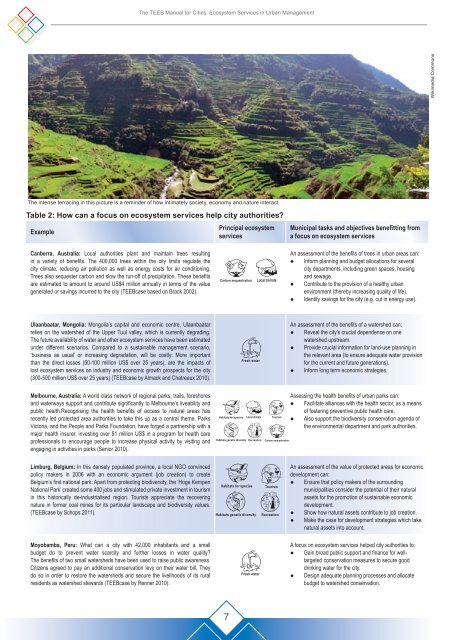TEEB Manual for Cities
TEEB Manual for Cities
TEEB Manual for Cities
Create successful ePaper yourself
Turn your PDF publications into a flip-book with our unique Google optimized e-Paper software.
The <strong>TEEB</strong> <strong>Manual</strong> <strong>for</strong> <strong>Cities</strong>: Ecosystem Services in Urban ManagementWikimedia CommonsThe intense terracing in this picture is a reminder of how intimately society, economy and nature interact.Table 2: How can a focus on ecosystem services help city authorities?ExampleCanberra, Australia: Local authorities plant and maintain trees resultingin a variety of benefits. The 400,000 trees within the city limits regulate thecity climate, reducing air pollution as well as energy costs <strong>for</strong> air conditioning.Trees also sequester carbon and slow the run-off of precipitation. These benefitsare estimated to amount to around US$4 million annually in terms of the valuegenerated or savings incurred to the city (<strong>TEEB</strong>case based on Brack 2002).Principal ecosystemservicesMunicipal tasks and objectives benefitting froma focus on ecosystem servicesAn assessment of the benefits of trees in urban areas can:● In<strong>for</strong>m planning and budget allocations <strong>for</strong> severalcity departments, including green spaces, housingand sewage.● Contribute to the provision of a healthy urbanenvironment (thereby increasing quality of life).● Identify savings <strong>for</strong> the city (e.g. cut in energy use).Ulaanbaatar, Mongolia: Mongolia’s capital and economic centre, Ulaanbaatarrelies on the watershed of the Upper Tuul valley, which is currently degrading.The future availability of water and other ecosystem services have been estimatedunder different scenarios. Compared to a sustainable management scenario,‘business as usual’ or increasing degradation, will be costly: More importantthan the direct losses (50-100 million US$ over 25 years), are the impacts oflost ecosystem services on industry and economic growth prospects <strong>for</strong> the city(300-500 million US$ over 25 years) (<strong>TEEB</strong>case by Almack and Chatreaux 2010).An assessment of the benefits of a watershed can:● Reveal the city’s crucial dependence on onewatershed upstream.● Provide crucial in<strong>for</strong>mation <strong>for</strong> land-use planning inthe relevant area (to ensure adequate water provision<strong>for</strong> the current and future generations).● In<strong>for</strong>m long term economic strategies.Melbourne, Australia: A world class network of regional parks, trails, <strong>for</strong>eshoresand waterways support and contribute significantly to Melbourne’s liveability andpublic health.Recognising the health benefits of access to natural areas hasrecently led protected area authorities to take this up as a central theme. ParksVictoria, and the People and Parks Foundation, have <strong>for</strong>ged a partnership with amajor health insurer, investing over $1 million US$ in a program <strong>for</strong> health careprofessionals to encourage people to increase physical activity by visiting andengaging in activities in parks (Senior 2010).Assessing the health benefits of urban parks can:● Facilitate alliances with the health sector, as a meansof fostering preventive public health care.● Also support the biodiversity conservation agenda ofthe environmental department and park authorities.Limburg, Belgium: In this densely populated province, a local NGO convincedpolicy makers in 2006 with an economic argument (job creation) to createBelgium’s first national park: Apart from protecting biodiversity, the ‘Hoge KempenNational Park’ created some 400 jobs and stimulated private investment in tourismin this historically de-industrialised region. Tourists appreciate the recoveringnature in <strong>for</strong>mer coal mines <strong>for</strong> its particular landscape and biodiversity values.(<strong>TEEB</strong>case by Schops 2011).Moyobamba, Peru: What can a city with 42,000 inhabitants and a smallbudget do to prevent water scarcity and further losses in water quality?The benefits of two small watersheds have been used to raise public awareness.Citizens agreed to pay an additional conservation levy on their water bill. Theydo so in order to restore the watersheds and secure the livelihoods of its ruralresidents as watershed stewards (<strong>TEEB</strong>case by Renner 2010).An assessment of the value of protected areas <strong>for</strong> economicdevelopment can:● Ensure that policy makers of the surroundingmunicipalities consider the potential of their naturalassets <strong>for</strong> the promotion of sustainable economicdevelopment.● Show how natural assets contribute to job creation.● Make the case <strong>for</strong> development strategies which takenatural assets into account.A focus on ecosystem services helped city authorities to:● Gain broad public support and finance <strong>for</strong> welltargetedconservation measures to secure gooddrinking water <strong>for</strong> the city.● Design adequate planning processes and allocatebudget to watershed conservation.7
















